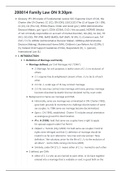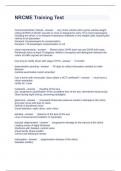200814 Family Law ON 9:30pm
Glossary: PFJ (Principles of Fundamental Justice) SCC (Supreme Court of CA), the
Charter (the CA Charter), CC (CC), ON (ON), LSUC/LSO (The LS of Upper CA / ON),
LS (LS), CA (The CA), POGG (Peace, Order and Good gov'), ADM (Administrative
Decision Maker), gov' (gov'), CDSA (CDSA), D (D / the accused), NCRMD (Verdict
of not criminally responsible on account of mental disorder), AG (AG), AL (AL), HC
(HC), GG (GG), PM (PM), BaRD (BaRD), BoP (BoP), W (W), CL (Common Law), ToF
(ToF), TJ (TJ), ADMer (Administrative Decision Maker), ADMing (Administrative
Decision Making), Matrimonial Home (MH), Children's Law Reform Act (CLRA), S
(S), Federal Child Support Guidelines (FCSG), Respondent (R), 人 (person),
International Law (IL)
I. INTRODUCTION
1. Definition of Marriage and Family
Marriage defined, per Civil Marriages Act ("CMA"):
2: Marriage, for civil purposes, is lawful union of 2 人s to exclusion of
others.
2.1: requires free & enlightened consent of two 人s to be Ss of each
other.
2.2: No 人 under age of 16 may contract marriage.
2.3: No one may contract new marriage until every previous marriage
has been dissolved by death/ divorce/ declared null by court order.
Background on Same-sex marriage and CMA
Historically, same-sex marriage was criminalized in ON. Charter (1982),
gave both grounds & momentum to challenge discrimination of same-
sex couples. In, 1986 same-sex marriage became decriminalized.
Egan v. CA (1995), established: Charter 15 includes sexual orientation
as analogous ground for discrimination.
M v. H (1999): held that same-sex couples have a right to apply
for spousal support under FLA Part III.
Halpern v. Toronto (City) (2003): CA held same-sex couples’ Const'al
rights were infringed and that CL definition of marriage should be
invalid in so far as it referred to “one man and one woman.” New
definition: “the voluntary union for the life of 2 人s to the exclusion of
all others" - led to CMA coming into force (2005)
Similarly, under DA 2(1), S means either of 2 人s married to each other
S defined, per CMA:
either of 2 人s who (a) are married to each other, or (b) have together
entered into a marriage that is voidable or void, in good faith on the
, part of 人 relying on this clause to assert any right.
Reference re Same-Sex Marriage, [2004] SCC
After a number of provinces had legalized same-sex marriage, SCC was
asked by federal gov' to give its opinion on 4 q's on draft legislation:
Q1: Jurisdiction of the draft legislations
Held: Capacity to marry: within the exclusive jurisdiction of Parl',
Solemnization of marriage: provincial jurisdiction.
Q2: Is proposed legislation consistent with the Charter?
Held: Consistent; doesn't violate right to some groups' religious
freedom. "The mere recognition of the equality rights of one
group cannot, in itself, constitute a violation of the rights of
another. The promotion of Charter rights and values enriches our
society as a whole and the furtherance of those rights cannot
undermine the very principles the Charter was meant to foster."
Q3: Does guarantee of freedom of religion in Charter protect religious
officials from being compelled to perform a marriage between 2 人s of
the same sex that is contrary to their religious beliefs?
Held: Yes. Guarantee of religious freedom in Charter 2(a) broad
enough to protect religious officials from being compelled by
State to perform civil/ religious same-sex marriages.
Q4: Is opposite-sex requirement for marriage for civil purposes, which
had been established by CL and set out for QB in Harmonization Act 5
consistent with Charter?
Held: Exercised discretion to refuse to answer q' as it served "no
legal purpose". Court wished to respect the lower-court decisions
upholding same-sex marriage by letting them stand.
Civil Marriage of Non-Residents Act ("CMNRA")
CMA was enacted in 2005 to extend to same-sex couples the legal
capacity to marry for civil purposes, last step in the long process to
enable same-sex couples to marry in CA. However, the flip side: right
to divorce, this is where matters became complicated for couples who
married in CA but later left. Per DA, in order to obtain a CA divorce, at
least one of Ss has to have lived in CA for at least one (1) year (the
“one-year residency requirement”).
CMNRA came about in 2013, having "addressed unfairness faced by
couples who came to CA to get married in good faith, but who then
found they were unable to dissolve their marriage because their CA
marriage is not recognized in their country/ state of residence."
Establishes new divorce process that allows CA courts to grant divorce
to non-resident Ss residing in state where a divorce cannot be granted
because state doesn't recognize the validity of their marriage.
, CMNRA: Divorce — non-resident Ss
7. (1) The court of the province where the marriage was performed
may, on application, grant Ss a divorce if
(a) there has been a breakdown of the marriage as established by
Ss having lived separate and apart for at least 1y before making
of app;
(b) neither S resides in CA at time application is made; and
(c) each of the Ss is residing — and for at least 1y immediately
before app is made, has resided — in a state where a divorce
cannot be granted because that state does not recognize the
validity of the marriage.
Québec (AG) v. A (aka the Eric and Lola case) - SCC
Equality rights challenge to Civil Code of QB (CCQ), and its exclusion
of de facto Ss from property-sharing and spousal support provisions
upon breakdown of marriage and civil union relationships. L (Lola), was
in a de facto relationship with E (Eric) for several years, 3 children
together; met when L was 17 & student, B wealthy 32. L stayed home, E
provided financially. L wanted to marry, E didn't believe in marriage.
Separated later, L's claim to use of family residence and E paying
monthly spousal support were resolved, but L challenged CCQ
provisions excluding her, as de facto S, from spousal support and
property-sharing benefits available to married and civil union Ss.
Q1. Is excluding de facto Ss from CCQ provisions mandating property-
sharing and spousal support on breakdown of marriages and civil
unions violating equality guarantee in Charter 15(1)?
Yes. But note dissenting opinions.
Q2: Was the violation of Charter 15(1) justified under Charter 1?
Yes. So - unmarried QB couples who later split up NOT entitled to
same rights as legally married couples on spousal support.
Kerr v. Baranow and Vanasse v. Seguin, [2011] - SCC
V was in a common-law relationship for 12y. For 3.5y during it, she
took leave from employment and stayed at home to care for children.
V's partner, CEO of his business, worked long hours and traveled
extensively. When separated in 2005, couple were in starkly contrasting
financial positions. V initiated proceedings claiming unjust enrichment,
arguing her providing childcare and domestic services had enabled
partner to pursue his business interests.
Held: V entitled to half the value of wealth partner accumulated during
period of unjust enrichment (- her interest in home and retirement
plans in her name).
, Significance: first time court clarified that Ss can claim share in the
wealth accumulated during a relationship.
Ratio https://casebrief.fandom.com/wiki/Kerr_v_Baranow
Monetary damages are not restricted to quantum meruit.
*Latin for "as much as he deserved," the actual value of services performed.
Quantum meruit determines the amount to be paid for services when no
contract exists or when there is doubt as to the amount due for the work
performed but done under circumstances when payment could be expected.
To demonstrate a joint family venture ("JVF"), complainant must
adduce evidence of: 1) Mutual effort, 2) Economic integration, 3)
Actual intent, 4) priority of the family
If a JVF can be proven, then if applicant can demonstrate a link
between their contributions and that a monetary award would be
insufficient, complainant entitled to a share of the assets
proportionate to their contributions.
To be entitled to a monetary remedy from a JVF, must show both
1) that a JVF exists, and 2) that there is a link between the
contributions to it and the accumulation of assets/wealth.
Generally, spousal support begins at date of the initial application,
though court has discretion to choose appropriate date in light of
circumstances.
2. Const'al Framework
In CA, family law is primarily statute-based. Federal gov' has exclusive
jurisdiction over marriage and divorce under Const' Act, 1867 s91(26). Main
piece of federal legislation governing the issues arising upon married Ss’
separation and requirements for divorce: DA.
Zacks v. Zacks: Pursuant to DA, federal gov' has jurisdiction over child
custody and access matters and spousal and child support during or after
divorce.
DA does not govern property issues.
Provinces have exclusive jurisdiction over the *solemnization of
marriage per Const' Act, 1867, s92(12) and spousal and child support,
property division, custody and access, adoption, and child protection as
part of the provincial gov''s jurisdiction over property and civil
rights under Const' Act 1867 s92(13) and jurisdiction over matters of a
private nature under s92(16) of the Act. Each province has an Act that
addresses rules of property division upon marriage breakdown (FLA)
*duly perform (a ceremony, especially that of marriage)
3. Fragmentation of Judicial Jurisdiction
ON's Family Courts Structure
In ON, family law matters are heard in: the ON Court of Justice, the
Superior Court of Justice, or the Family Court branch of the Superior
, Court of Justice, depending on the issue in dispute and where you are
located in the province.
Family Court (aka unified Family Court)
有 25 Family Court of the Superior Court of Justice locations in
ON: Barrie, Belleville, Bracebridge, Brockville, Cayuga, Cobourg,
Cornwall, Hamilton, Kingston, Kitchener, Lindsay, London,
L’Orignal, Napanee, Newmarket, Oshawa/Whitby, Ottawa,
Pembroke, Perth, Peterborough, Picton, Simcoe, St. Catharines, St.
Thomas and Welland.
Where the Family Court branch exists, the court hears all family
law matters, including divorce, division of property, child and
spousal support, custody and access, adoption, and child
protection applications. In all other sites across the province,
family law matters are divided between the ON Court of Justice
and the Superior Court of Justice.
ON Court of Justice
hears family law disputes that fall under most ON legislation.
Issues include: custody, access, child and spousal support,
adoption and child protection applications; ON Court of Justice
does not decide divorce or division of property matters.
Superior Court of Justice
can decide family law disputes involving divorce, division of
property, child and spousal support, and custody and access;
does not hear adoption and child protection matters, except on
appeal.
DA 2: court, in respect of a province, means (a) for ON, the Superior Court of
Justice, Js appointed by federal gov'
FLA 1(1) on jurisdiction in respect of family matters: “court” means ON Court
of Justice, the Family Court of the Superior Court of Justice, or the Superior
Court of Justice
FLA 4(1): division of family property
“court” means a court as defined in subsection 1 (1), but does not
include the ON Court of Justice;
FLA 34(3): Limitation on jurisdiction of ON Court of Justice
(2) ON Court of Justice shall not make an order under clause (1) (b)
lump sum payment, (c) transferring of property, (i) designating life
insurance policy to specified beneficiary , (j) change pension plan
beneficiary or (k) requiring securing payment by charge on property
except for provision of necessities or to prevent dependant from
becoming/ continuing to be a public charge, and shall not make an






